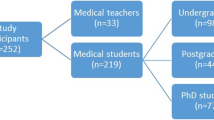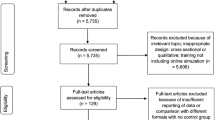Abstract
The use of Virtual Patient (VP) across various settings in medical education incorporates interactive activities to promote interactive learning. Instructional interventions provided by VP emphasize students’ understanding and knowledge integration. Case-based learning in the form of VP simulations is considered to be an appropriate teaching modality for clinical reasoning skills. Despite VP having been widely adopted in medical and health profession education, its potential to enhance students’ collaborative and reflective skills in supporting interprofessional education (IPE) is poorly maximized. VP development to facilitate IPE in medical and health professions education remains limited. This study aimed to develop design principles for a web-based VP simulation for interprofessional learning. We conducted a literature review to discover essential aspects to consider during the VP development. Characteristics from existing VP simulations were included in the design process combined with the Four Core Competencies for Interprofessional Collaborative Practice. In this study, we present two design principles associated with VP in IPE: (1) general user interface recommendations; and (2) features to stimulate IPE. The simple and intuitive interface presented by the VP was devoted to the students in achieving IPE competencies, including value/ethics, roles/responsibilities, interprofessional communication, and teams and teamwork. Suggested combinations of learning resources and technical requirements provided in this paper motivate educational organizations to implement a tailored approach based on institutional characteristics and student profiles.
Access this chapter
Tax calculation will be finalised at checkout
Purchases are for personal use only
Similar content being viewed by others
Abbreviations
- IPC:
-
: Interprofessional Collaboration
- IPE:
-
: Interprofessional Education
- UI:
-
: User Interface
- VP:
-
: Virtual Patients
References
Alkema W, Rullmann T, van Elsas A (2006) Target validation in silico: does the virtual patient cure the pharma pipeline? Expert Opin Ther Targets 10:635–638
Darmon D, Sauvant R, Staccini P, Letrilliart L (2014) Which functionalities are available in the electronic health record systems used by French general practitioners?: an assessment study of 15 systems. Int J Med Inform 83:37–46. https://doi.org/10.1016/j.ijmedinf.2013.10.004
Consorti F, Mancuso R, Nocioni M, Piccolo A (2012) Efficacy of virtual patients in medical education: a meta-analysis of randomized studies. Comput Educ 59:1001–1008. https://doi.org/10.1016/j.compedu.2012.04.017
Cendan JC, Lok B (2012) The use of virtual patients in medical school curricula. Adv Physiol Educ 36:48–53. https://doi.org/10.1152/advan.00054.2011
Stevens A, Hernandez J, Johnsen K, Dickerson R, Raij A, Harrison C et al (2006) The use of virtual patients to teach medical students history taking and communication skills. Am J Surg 191:806–811. https://doi.org/10.1016/j.amjsurg.2006.03.002
Lehmann R, Bosse HM, Simon A, Nikendei C, Huwendiek S (2013) An innovative blended learning approach using virtual patients as preparation for skills laboratory training: perceptions of students and tutors. BMC Med Educ 13:1–9. https://doi.org/10.1186/1472-6920-13-23
von Zadow U, Buron S, Harms T, Behringer F, Sostmann K, Dachselt R. SimMed: Combining simulation and interactive tabletops for medical education. Conference on Human Factors in Computing Systems - Proceedings. 2013:1469–78.
Ellaway RH (2014) Virtual patients as activities: exploring the research implications of an activity theoretical stance. Perspect Med Educ. 3:266–277
Candler C, Aschenbrener CA (2010) Case Study 1 Effective Use of Educational Technology in Medical Education
Kenny P, Parsons TD, Gratch J, Leuski A, Rizzo AA (2007) Virtual patients for clinical therapist skills training. Intelligent Virtual Agents. IVA :197–210. https://doi.org/10.1007/978-3-540-74997-4_19
Fall LH, Berman NB, Smith S, White CB, Woodhead JC, Olson AL (2005) Multi-institutional development and utilization of a computer-assisted learning program for the pediatrics clerkship: the CLIPP Project. Acad Med 80:847–855. https://doi.org/10.1097/00001888-200509000-00012
Shoemaker MJ, de Voest M, Booth A, Meny L, Victor J (2015) A virtual patient educational activity to improve interprofessional competencies: a randomized trial. J Interprof Care 29:395–397. https://doi.org/10.3109/13561820.2014.984286
Gilbert JHV, Yan J, Hoffman SJ (2010) A WHO report: Framework for action on interprofessional education and collaborative practice. J Allied Health 39(SUPPL. 1):196–197
Green BN, Johnson CD (2015) Interprofessional collaboration in research, education, and clinical practice: working together for a better future. J Chiropr Educ 29:1–10. https://doi.org/10.7899/JCE-14-36
Anderson ES (2016) Evaluating interprofessional education: an important step to improving practice and influencing policy. J Taibah Univ Med Sci. 11:571–578. https://doi.org/10.1016/j.jtumed.2016.08.012
Bridges DR, Davidson RA, Odegard PS, Maki I v., Tomkowiak J. Interprofessional collaboration: three best practice models of interprofessional education. Med Educ Online. 2011;16:0–10. doi: https://doi.org/10.3402/meo.v16i0.6035
Stubbs C, Schorn MN, Leavell JP, Espiritu EW, Davis G, Gentry CK, et al (2017) Implementing and evaluating a community-based, inter-institutional, interprofessional education pilot programme. J Interprof Care. :1–4. https://doi.org/10.1080/13561820.2017.1343808.
Feng JY, Chang YT, Chang HY, Erdley WS, Lin CH, Chang YJ (2013) Systematic review of effectiveness of situated e-learning on medical and nursing education. Worldviews Evid Based Nurs. 10:174–183
Cook DA, Erwin PJ, Triola MM (2010) Computerized virtual patients in health professions education: a systematic review and meta-analysis. Acad Med 85:1589–1602
Crowe S, Creswell K, Robertson A, Huby G, Avery A, Sheikh A (2011) The case study approach. BMC Med Res Methodol 11
Swedish Research Council (2017) Vetenskapradet. Good Research Practice
Office for Human Research Protections. Exemptions (2018 Requirements) | HHS.gov. 2021. https://www.hhs.gov/ohrp/regulations-and-policy/regulations/45-cfr-46/common-rule-subpart-a-46104/index.html. Accessed 23 Nov 2022
Cela-Ranilla JM, Esteve-Mon FM, Esteve-González V, Gisbert-Cervera M (2014) Develo** self-management and teamwork using digital games in 3D simulations. Australas J Educ Technol 30:634–651
Cook DA, Triola MM (2009) Virtual patients: a critical literature review and proposed next steps. Med Educ 43:303–311
Issenberg SB, McGaghie WC, Petrusa ER, Gordon DL, Scalese RJ (2005) Features and uses of high-fidelity medical simulations that lead to effective learning: a BEME systematic review. Med Teach 27:10–28
Chittaro L, Ranon R (2007) Web3D technologies in learning, education and training: motivations, issues, opportunities. Comput Educ 49:3–18
Schmitt M, Blue A, Aschenbrener CA, Viggiano TR (2011) Core competencies for interprofessional collaborative practice: reforming health care by transforming health professionals’ education. Aca Med. 86:1351. https://doi.org/10.1097/ACM.0b013e3182308e39
Tran C, Toth-Pal E, Ekblad S, Fors U, Salminen H (2020) A virtual patient model for students’ interprofessional learning in primary healthcare. PLoS ONE. 15 9 September 2020
Hege I, Kononowicz AA, Tolks D, Edelbring S, Kuehlmeyer K (2016) A qualitative analysis of virtual patient descriptions in healthcare education based on a systematic literature review. BMC Med Educ 16. https://doi.org/10.1186/s12909-016-0655-8.
Imison M, Hughes C (2022) The virtual patient project: using low fidelity, student generated online cases in medical education. ResearchGate
Tworek J, Coderre S, Wright B, McLaughlin K (2010) Virtual patients: ED-2 band-aid or valuable asset in the learning portfolio? Acad Med 85:155–158. https://doi.org/10.1097/ACM.0b013e3181c4f8bf
Utomo PS, Sumunar DSEW, Greviana N, Soemantri D, Claramita M (2022) Intellectual Property Rights of an Electronic Portfolio Platform. Min. of Law Rep. of Indonesia. No. EC00202267866
Competing Interest
The authors declare no competing interests related to this study.
Authors' Contribution
Dimas Sumunar—develo** research proposal, collecting data, data analysis, and publication of the manuscript.
Natalia Stathakarou—develo** research proposal, data analysis, and publication of the manuscript.
Andrzej A Kononowicz—data analysis and publication of the manuscript.
Klas Karlgren—data analysis and publication of the manuscript.
Author information
Authors and Affiliations
Corresponding author
Editor information
Editors and Affiliations
Rights and permissions
Copyright information
© 2023 The Author(s), under exclusive license to Springer Nature Singapore Pte Ltd.
About this paper
Cite this paper
Sumunar, D.S.E.W., Stathakarou, N., Kononowicz, A.A., Karlgren, K. (2023). Implementation of Design Principles for Virtual Patient Simulation in Interprofessional Education. In: Claramita, M., Soemantri, D., Hidayah, R.N., Findyartini, A., Samarasekera, D.D. (eds) Character Building and Competence Development in Medical and Health Professions Education. INA-MHPEC 2022. Springer Proceedings in Humanities and Social Sciences. Springer, Singapore. https://doi.org/10.1007/978-981-99-4573-3_16
Download citation
DOI: https://doi.org/10.1007/978-981-99-4573-3_16
Published:
Publisher Name: Springer, Singapore
Print ISBN: 978-981-99-4572-6
Online ISBN: 978-981-99-4573-3
eBook Packages: MedicineMedicine (R0)




